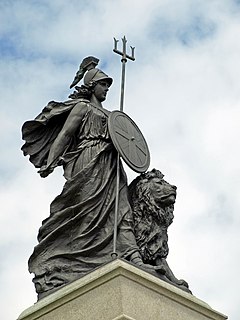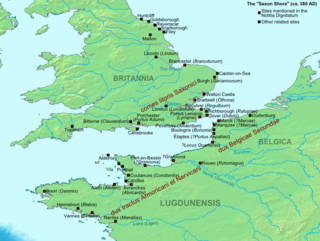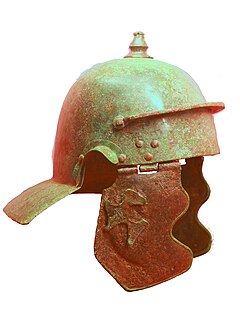| Cohors I Aquitanorum | |
|---|---|
 Roman infantry helmet (late 1st century) | |
| Active | early 1st century to 4th century |
| Country | Roman Empire |
| Type | Roman auxiliary cohort |
| Role | infantry |
| Size | 480 men |
| Garrison/HQ | Germania Superior 84-122; Britannia 122 - 4th century |
Cohors prima Aquitanorum ("1st Cohort of Aquitani") was a Roman auxiliary infantry regiment. It was probably originally raised in Gallia Aquitania in the reign of founder-emperor Augustus after the revolt of the Aquitani was suppressed in 26 BC. [1] Unlike most Gauls, the Aquitani were not Celtic-speaking but spoke Aquitanian, a now extinct non Indo-European language closely related to Basque.

Gallia Aquitania, also known as Aquitaine or Aquitaine Gaul, was a province of the Roman Empire. It lies in present-day southwest France, where it gives its name to the modern region of Aquitaine. It was bordered by the provinces of Gallia Lugdunensis, Gallia Narbonensis, and Hispania Tarraconensis.

Augustus was a Roman statesman and military leader who was the first emperor of the Roman Empire, reigning from 27 BC until his death in AD 14. His status as the founder of the Roman Principate has consolidated an enduring legacy as one of the most effective and controversial leaders in human history. The reign of Augustus initiated an era of relative peace known as the Pax Romana. The Roman world was largely free from large-scale conflict for more than two centuries, despite continuous wars of imperial expansion on the Empire's frontiers and the year-long civil war known as the "Year of the Four Emperors" over the imperial succession.

The Aquitanians were a people living in what is now southern Aquitaine and southwestern Midi-Pyrénées, France, called Gallia Aquitania by the Romans in the region between the Pyrenees, the Atlantic ocean, and the Garonne, present-day southwestern France. Classical authors such as Julius Caesar and Strabo clearly distinguish them from the other peoples of Gaul, and note their similarity to others in the Iberian Peninsula.
Contents
There is scholarly controversy about whether there were one or two infantry cohortes called I Aquitanorum. This is because a regiment of that name is repeatedly attested both in Germania Superior and Britannia. Holder sees them as two separate units, one of which carried the title veterana and was permanently based in Germania Sup., the other in Britannia. [2] Spaul considers it more likely there was a single unit, which alternated between the two provinces, although this was unusual for auxiliary regiments. [3] Holder's view is supported by the fact that none of the British inscriptions carry the title veterana, whereas several of the German ones do, and so appears more likely. Holder is followed here: this article concerns the unit stationed in Britannia. For the unit in Germania Sup. see cohors I Aquitanorum veterana.

Germania Superior was an imperial province of the Roman Empire. It comprised an area of today's western Switzerland, the French Jura and Alsace regions, and southwestern Germany. Important cities were Besançon (Vesontio), Strasbourg (Argentoratum), Wiesbaden, and Germania Superior's capital, Mainz (Mogontiacum). It comprised the Middle Rhine, bordering on the Limes Germanicus, and on the Alpine province of Raetia to the south-east. Although it had been occupied militarily since the reign of Augustus, Germania Superior was not made into an official province until c. 85 AD.

Britannia has been used in several different senses. The name is a Latinisation of the native Brittonic word for the island, Pretanī, which also produced the Greek form Prettanike or Brettaniai, which originally, in the fourth to the first centuries BC, designated a collection of islands with individual names, including Albion or Britain. In Modern Welsh the name remains Prydain. By the 1st century BC, Britannia came to be used for Great Britain specifically. After the Roman conquest in 43 AD, Britannia meant Roman Britain, a province covering the island south of Caledonia. When Roman Britain was divided into four provinces in 197 AD, two were called Britannia Superior and Britannia Inferior. Britannia is the name given to the female personification of the island, and it is a term still used to refer to the whole island.
Cohors prima Aquitanorum veterana was a Roman auxiliary infantry regiment. It was probably originally raised in Gallia Aquitania in the reign of founder-emperor Augustus after the revolt of the Aquitani was suppressed in 26 BC. Unlike most Gauls, the Aquitani were not Celtic-speaking but spoke Aquitanian, a now extinct non- Indo-European language closely related to Basque.
The regiment was probably stationed on the Rhine frontier from an early stage. [1] It first appears in the datable epigraphic record in 82 AD in Germania, if this record does not relate to its namesake unit. The regiment is first attested in Britannia in 122, probably transferred to the island along with several other regiments to help in the construction of Hadrian's Wall (122-32). The regiment remained in Britain into the 4th century, as it left an inscription in the Saxon Shore fort of Branodunum (Brancaster, Norfolk). The regiments is attested in the following Roman forts in Britain: Bakewell, Brancaster (4th century), Brough-on-Noe (158), Carrawburgh. [4]

Hadrian's Wall, also called the Roman Wall, Picts' Wall, or Vallum Hadriani in Latin, was a defensive fortification in the Roman province of Britannia, begun in AD 122 in the reign of the emperor Hadrian. It ran from the banks of the River Tyne near the North Sea to the Solway Firth on the Irish Sea, and was the northern limit of the Roman Empire, immediately north of which were the lands of the northern Ancient Britons, including the Picts.

The Saxon Shore was a military command of the late Roman Empire, consisting of a series of fortifications on both sides of the English Channel. It was established in the late 3rd century and was led by the "Count of the Saxon Shore". In the late 4th century, his functions were limited to Britain, while the fortifications in Gaul were established as separate commands. Several Saxon Shore forts survive in east and south-east England.

Branodunum was the name of an ancient Roman fort to the east of the modern English village of Brancaster in Norfolk. Its Roman name derives from the local Celtic language, and may mean "fort of the raven".
Although a few names of praefecti (commanders) of the regiment have been preserved, none have a certain origin. One miles (common soldier) has a partially preserved origin "Cam-". This may be Camulodunum (Colchester).

Camulodunum, the Ancient Roman name for what is now Colchester in Essex, was an important town in Roman Britain, and the first capital of the province. It is claimed to be the oldest town in Britain. Originally the site of the Brythonic-Celtic oppidum of Camulodunon, capital of the Trinovantes and later the Catuvellauni tribes, it was first mentioned by name on coinage minted by the chieftain Tasciovanus sometime between 20 and 10 BC. The Roman town began life as a Roman Legionary base constructed in the AD 40s on the site of the Brythonic-Celtic fortress following its conquest by the Emperor Claudius. After the early town was destroyed during the Iceni rebellion in 60/1 AD, it was rebuilt, reaching its zenith in the 2nd and 3rd centuries. During this time it was known by its official name Colonia Claudia Victricensis, often shortened to Colonia Victricensis, and as Camulodunum, a Latinised version of its original Brythonic name. The town was home to a large classical Temple, two theatres, several Romano-British temples, Britain's only known chariot circus, Britain's first town walls, several large cemeteries and over 50 known mosaics and tessellated pavements. It may have reached a population of 30,000 at its height. It was not until the late 18th century that historians realised that Colchester's physical Brythonic and Roman remains were the city mentioned in ancient literature as "Camulodunum".

